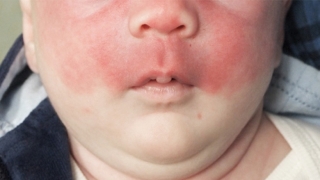Capillary Vascular Malformations: Port Wine Stains
What are capillary malformations (port wine stains)?
Capillary malformations are flat patches of pink or purple skin that can occur anywhere on the head, body and extremities. They occur in 3 out of every 1,000 births, and the pink or purple color is due to dilated capillary vessels just under the skin. They grow proportionately with the child, and although they do not spread out to cover unaffected skin, they can darken and thicken over time as the vessels slowly dilate as the child gets older.
 “Port wine stain” is a specific type of capillary malformation that usually involves only one side of the body and is more purple, but this term is also used interchangeably with capillary malformation.
“Port wine stain” is a specific type of capillary malformation that usually involves only one side of the body and is more purple, but this term is also used interchangeably with capillary malformation.
Most often, a child has a single capillary malformation without any other associated medical problems. Rarely, a capillary malformation can be a sign of a deeper vascular anomaly or other associated syndrome or medical problem. Examples of these associated syndromes may include:
Diffuse capillary vascular malformation with overgrowth (DCMO)
DCMO patients have a network of port wine stains — “diffuse” means that it affects more than one anatomical region. “Overgrowth” means enlargement of a body region, most commonly of a limb.
Diffuse capillary vascular malformation with undergrowth (DCMU)
DCMU patients have a network of port wine stains — “diffuse” means that it affects more than one anatomical region. “Undergrowth” means a certain area of the body is proportionally smaller. This might cause, for example, one leg to be thinner or shorter than the other.
Cutis marmorata telangiectatica congenita (CMTC)
CMTC is a rare skin condition in which dilated blood vessels beneath the skin’s surface look more purple but also create a marbled-looking pattern and often atrophy of the skin. “Cutis marmorata” means marbled skin, which can occur as a normal response to cold and then reverses when the body warms up. CMTC does not reverse with warming up. “Telangiectatic” means abnormal blood vessels. “Congenita” means congenital, or existing at birth.
Sturge-Weber syndrome (SWS)
Sturge-Weber syndrome (SWS) is a type of neurocutaneous syndrome, a broad term for a group of rare neurological disorders affecting the brain, spine, peripheral nerves and the skin. The classic symptom of this condition is a port wine stain (capillary vacular malformation) located on the face, specifically on the forehead and/or upper eyelid areas. A port wine stain is present from birth and varies in color from red to dark purple. Most children with facial port wine stains do not have SWS. If they do have SWS, there may also be associated brain abnormalities on the same side of the brain as the face lesion. Periodic evaluation by an ophthalmologist beginning immediately after birth is recommended because of the risk of glaucoma. Patients with central nervous system involvement can have seizures. Brain MRI may be obtained to asses for the brain changes of SWS.
What causes capillary malformations?
Capillary malformations occur when the skin has larger blood vessels close to the surface, which makes the blood vessels more visible. They are believed to be caused by genetic mutations that occur before the child is born.
How are capillary malformations diagnosed?
A patient is seen at Children's Hospital of Philadelphia’s (CHOP) Comprehensive Vascular Anomalies Program (CVAP), which includes the multiple specialists involved in the care of children with capillary vascular malformations. Typically, a thorough medical history and physical examination is all that is needed, but at times additional diagnostic testing (such as a MRI) may be needed.
What are the treatment options?
If the child has no underlying complications from the capillary malformation, there may be no treatment required. If treatment is preferred, then the treatment of choice for capillary malformations is pulsed dye laser therapy. The laser light is absorbed by the blood inside the vessels, which causes them to heat up rapidly and burst. The treatment causes temporary bruising and then gradual lightening of the pink or purple color. Your child’s medical team will decide whether the treatments can be done in an office, or if it is better to perform the treatments under a brief general anesthetic in the operating room. Ideally, the treatment is started in infancy to prevent the blood vessels from overgrowing and becoming more difficult to treat.
Before undergoing laser treatments, patients should understand that multiple laser treatments may be necessary to achieve the best results, and that the laser cannot completely remove the color. The current lasers cannot penetrate deeply enough to reach all the vessels, and therefore treatment is discontinued once improvement is no longer visible. Different parts of the body may respond differently to the laser. The laser tends to be less effective when used near the hands and feet, so laser treatment of the face and neck is generally more successful than that of the extremities.
The CHOP difference
Children seen by the CVAP team at CHOP benefit from a multidisciplinary team with extensive experience and deep expertise in the assessment and management of capillary malformations. World-class specialists offer comprehensive care tailored to each child’s condition. The CVAP team at CHOP supports patients and their families every step of the way in their journey in managing a diagnosis of capillary vascular malformations.
Reviewed by Michael D. Fox, MD, MEd, David W. Low, MD